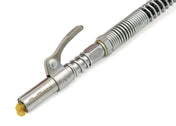Don’t Judge a Grease by Its Colour!
When browsing our range of greases, you’ll notice a wide variety of colours — from white, blue, and gold to black and even clear. But what does grease colour really mean?
Surprisingly, not much. Many people still judge greases by appearance, odour, and texture, but grease colour is not a reliable indicator of performance or quality
Does Grease Colour Matter?
There is no universal standard that links grease colour to its formulation or performance. This means you should never choose a grease based solely on its colour. Instead, always refer to the products technical data sheet (TDS) to ensure its suitable for your specific application.
Example: Our KAJO LZR2 multipurpose grease is a blue lithium soap-based grease. However, another brand may offer an amber lithium soap-based grease with the same thickener system but a completely different colour.
Why Do Manufacturers Use Coloured Greases?
Even though colour doesn’t dictate performance, coloured greases have practical benefits in real-world maintenance:
✅ Easy Identification: Different colours help users distinguish between grease types, grades, or applications. This reduces the risk of cross-contamination between incompatible greases.
✅ Detecting Degradation: Colour changes can signal grease breakdown. For instance, a red grease turning black may indicate oxidation, contamination, or thermal degradation.
✅ Leak & Over-Lubrication Detection: Coloured greases are easier to spot if there’s a leak, making maintenance more efficient and reducing downtime.
Can Grease Colour Change Over Time?
Yes. Various environmental and operating conditions can alter grease colour:
· UV Exposure: Sunlight fades the dyes in grease, making them appear lighter.
· Heat: Prolonged high temperatures accelerate oxidation, often causing grease to darken.
· Water Contamination: Water mixing with grease can alter both colour and texture.
These factors prove why colour alone should not be used to evaluate grease performance or suitability.
How to Select the Right Grease
While grease colour is helpful for maintenance visibility, it’s not a measure of quality. To ensure proper lubrication and equipment protection:
· Always check the TDS (Technical Data Sheet).
· Follow your equipment manufacturer’s lubrication specifications.
· Never assume two greases of the same colour are interchangeable.
In Short: Choose by Spec, Not by Shade
Grease colour is a practical tool for identification, but it is not a performance standard. Different manufacturers may use the same colour for completely different formulations, and identical formulations may vary in colour.
To avoid costly mistakes:
· Use grease colour for maintenance efficiency.
· Use the specifications for performance and compatibility.
Remember: Grease colour improves visibility — not quality.
FAQs
Q: Does grease colour indicate quality?
A: No, grease colour does not indicate quality or performance. Always check the Technical Data Sheet (TDS).
Q: Why are greases different colours?
A: Colours help with identification, prevent cross-contamination, and make leaks easier to spot.
Q: Can grease colour change over time?
A: Yes, due to heat, UV exposure, or contamination. This is not always a sign of failure but can indicate degradation.



